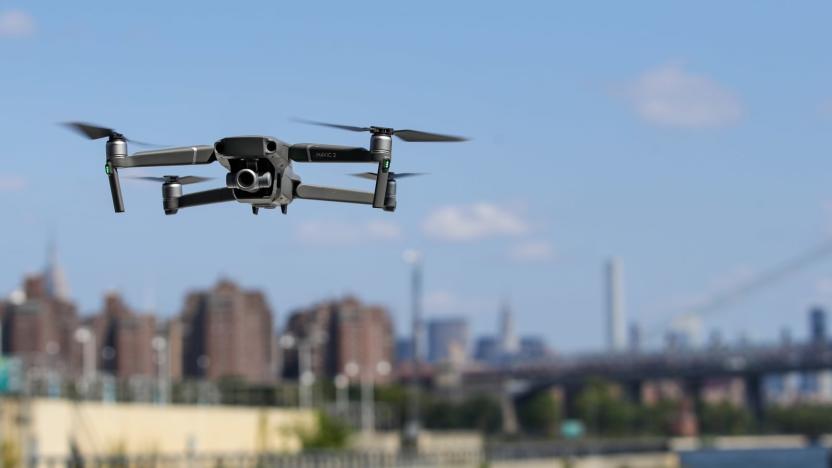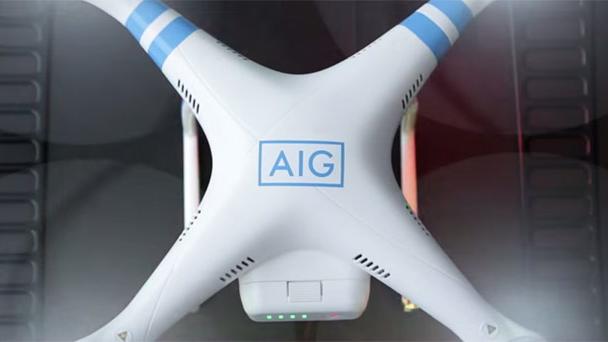inspection
Latest

Proposed NYC law would require drone inspections for building complaints
Drones could soon be key to keeping New Yorkers safe from crumbling architecture. Members of the New York City Council have proposed legislation that would require drone inspections within 48 hours of a complaint or confirmed violation. A robotic vehicle (not the Mavic 2 Pro pictured) would use infrared and a pair of conventional cameras to both look for the telltale temperature changes of cracks and inspect roof conditions. The intended drones would cost $2,500 each, but the proposal would reduce costs by offloading the inspections to private companies that would charge building owners.

An engineer allegedly falsified inspection reports for SpaceX rockets
Federal investigators believe a quality assurance engineer responsible for inspecting parts for SpaceX had been falsifying reports. The engineer works for New York-based PMI Industries and is accused of forging signatures on at least 38 inspection reports for parts intended for use in SpaceX's Falcon 9 and Falcon Heavy rockets. Authorities also found at least 76 parts that were rejected or not inspected but shipped to SpaceX anyway.

New York energy company is using drones for inspection
Different industries and companies use drones for different tasks. For New York energy provider Con Edison, that task is to inspect 10-story boilers that produce steam and energy for some of the most iconic buildings in NYC, including the Empire State. The company has begun testing the use of drones (equipped with cameras and thermal systems) for inspection at one of its steam plants on the East Side of Manhattan. Workers typically have to go through confined-space training and to build tall scaffoldings to check a plant's boilers. Con Edison's round, 1.1-pound carbon fiber machines can simply fly all over the place, capturing videos and photos.

FAA allows AIG to use drones for insurance inspections
The Federal Aviation Administration has been rather stingy when it comes to giving companies the OK to test, let alone employ, drones. After getting permission this week, AIG joins State Farm and USAA as insurance providers with exemptions that allow them to use the UAVs to perform tasks that are risky to regular folks -- things like roof inspections after a major storm. In addition to keeping its inspectors safe, the company says drones will speed up the claims process, which means its customers will, in theory, get paid faster. "UAVs can help accelerate surveys of disaster areas with high resolution images for faster claims handling, risk assessment, and payments," the news release explains. "They can also quickly and safely reach areas that could be dangerous or inaccessible for manual inspection, and they provide richer information about properties, structures, and claim events."

Samsung finishes initial Chinese factory audits, plans long-term solutions to labor woes
Samsung faced some serious allegations surrounding the plants of its Chinese contractor HEG Electronics earlier this month, including potentially dire accusations that HEG was employing child labor. The Korean firm promised audits to set the record straight, and we're seeing the first fruits of those inspections today. The results were decidedly mixed. While there weren't any underage workers when Samsung visited, it did find HEG staff working excessive overtime, some unsafe practices and a system that punished late workers with fines. Samsung's response will go beyond just asking HEG to shape up, though: it plans to finish auditing all 105 of its exclusive Chinese contractors by the end of September, determine whether inspections of non-exclusive contractors are needed and set up a long-term audit schedule past 2013 that includes tougher requirements. While there's no certainty that the reforms will lead to the intended results, we're glad to hear that Samsung wants to turn things around at such a rapid pace.

Robot Safety Center opens up in Japan, Crash Test Dummies still an unfortunate name for a band (video)
The fair city of Tsukuba, which (as you know) is located in Ibaraki Prefecture, Japan, has recently become home to the new Robot Safety Center. A collaboration between a number of organizations including Japan's Automobile Research Institute (JARI), the center has areas for testing various robots and exoskeletons for things like obstacle detection, electronic jamming resistance, durability, and more. As well as developing safety standards for the devices, it is hoped that within the next five years it will provide certification services for new robots as they become commercially available. Some eighteen tests have been installed at the facility thus far, and we must say that it looks like fun! See some examples after the break.

Daiwa House enlists Moogle for remote control crawlspace inspections
Apparently Japanese homebuilder Daiwa House offers crawl space inspections as part of its warranty service, and to that end have enlisted Moogle (rhymes with "goggle," not "Google"). The robot weighs just under 30 lbs, measures roughly 20 x 12 x 9.5 inches, and rocks a laser rangefinder, WiFi connectivity, and two cameras: one for driving, one for inspecting. If you happen to be in the country yourself and wish to try the thing out, it can be leased monthly for ¥40,000 ($500) or purchased outright for ¥200,000 ($2,500). Just brace yourself -- you never know what you're gonna find when you start digging around under people's houses. See it in action after the break.

Power line inspecting robot isn't afraid of getting juiced
Inspecting power lines isn't the safest job we can imagine having, so we're pretty happy to see that robots -- which don't have the same... feelings we do about getting injured -- can be hacked to do the job. Hydro-Quebec's LineScout can get past most power line obstacles by partially detaching itself from the line and then grabbing a hold of it again once said obstacle has been cleared. It can also easily get from one section of the line to the next relatively quickly, and of course, the best part of this bot's ability is that it can pull all this off while the lines are powered. Check out the video below to see the bot in action.

LEXID prototype gun can peek through walls
Believe it or not, devices used to see through walls are far from revolutionary, but hey, we'll take every one we can get. Reportedly, Physical Optics Corporation has concocted a prototype gun that utilizes the same method of viewing that a lobster does to see what's ahead in murky waters. The LEXID (Lobster Eye X-ray Imaging Device) functions by "radiating objects with tiny amounts of X-ray energy," subsequently allowing its user to see behind steel, wood or concrete. According to David Throckmorton, a project manager in Homeland Security's Science and Technology division, the resulting images aren't exactly drool-worthy, but they do allow you to make out a stash of weapons or a crouching enemy. Unfortunately, completion is too far out to estimate a price, but its creators are hoping to one day make it cheap enough for exterminators and contractors to purchase and use. 'Course, we could imagine middle schoolers getting into all sorts of trouble if one of these floated into the locker room.[Via The Raw Feed, image courtesy of POC]

Sanyo creates inspection robot to check structural integrity
This certainly won't go down as the first underfloor robot we've heard about, but apparently, Sanyo's aiming to use all these fantastic ideas to actually bring a product to market. The fairly attractive bot is designed to cruise underneath apartment buildings, offices and essentially any other place of residence to check for structural damage, and it boasts integrated sensors that enable it to avoid obstacles while on duty. Apparently, the creation -- which can scoot about for just over two hours on a full charge -- can beam back live video of what it sees, and landlords can zoom in on curious spots to find out if there are indeed any problems that need attention. Unfortunately, we're hearing that it won't be on sale till next year, but it shouldn't cost much more than ¥1,000,000 ($8,736) when it finally arrives -- which, by our estimation, is a small price to pay to avoid months of back problems and terrifying encounters with all sorts of rodents.[Via AkihabaraNews]

Robotic Cable Inspection System checks for damage on electrical conduits
It's true that we've never met a robot that we didn't like (ok, those snakebots were a bit weird) -- while we're a sucker for nursebots and singerbots and bartenderbots, we're especially partial to those silicon-based lifeforms that can perform some tedious and important task that would be pretty tough for us humans to do ourselves. The latest one we've spotted that fits this bill is a bot created by researchers at the University of Washington, which can crawl along high-voltage power cables to inspect their integrity before they blow up and/or cause some sort of significant damage. The Robotic Cable Inspection System is able to detect problems with the infrastructure via its heat sensor, acoustic sensor and "water tree" detector that examines if water has gotten into the insulation. Earlier this week, the team completed the robot's first field test at the Lockheed Martin Michoud NASA Assembly Facility in New Orleans as a way to promote more safety bots in work environments. We just hope that if the little guy does find damage that it's got time to scamper away before being shorted out itself. [Via Robot Gossip]

Japanese under-floor inspection bot announced
If you grew up / live in a house that has a crawl-space underneath and were (or perhaps still are) the one who gets pegged for crawling under the house to run television or Ethernet cables, then this robot will come as a blessing. Our robot-breeding friends over in Japan -- at the Chiba Institute of Technology and the University of Tsukuba -- have announced the development of a crawling robot that can slide across dirt floors and lift itself over plumbing and other pipes. It's designed to fit spaces 500 millimeters (19.68 inches) wide and 300 millimeters (11.8 inches) tall, and a remote allows you to steer it around and shoot still images of your crumbling foundation (we also assume it can transmit them live to a display somewhere). Currently, the unnamed bot is only being tested on the CIT campus, but prototypes are expected to be unleashed by March 2007, with full commercial production coming by April 2008. While this bot doesn't yet (from what we gather) know how to lay cable, we really hope someone teaches them how, given that it's no fun to spend the better part of an hour crawling around under a house to lay an Ethernet cable, only to find that it's a foot short -- not that we're still bitter about that one hellacious day in 1998 or anything.

New inspection bots inspired by bat sonar
With all the world domination posturing by robots, you wouldn't think they'd be so dang good all this humanitarian and safety-related stuff, but it seems if they aren't busy pulling somebody out of a building, they're inspecting those very buildings for structural integrity. These new bots by the University of Strathclyde fall into that latter category, and use bat-inspired echolocation to navigate and inspect their surroundings. The robots report back to a mission control computer which manages the group of robo-inspectors based on the collective findings. There's also a camera on board each bot, along with a magnet to test for corrosion. It doesn't look like these bots will make it to market for another 10 years, but when they do they're expected to make the job of inspecting nuclear installations and gas pipelines a whole lot more fun.





